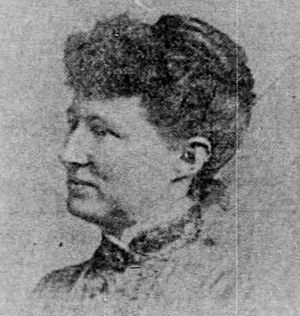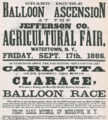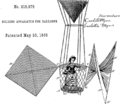Mary Myers facts for kids
Mary Myers (born Mary Breed Hawley; 1849–1932) was an amazing professional balloonist. She also invented things for flying! Many people knew her as "Carlotta, the Lady Aeronaut."
Mary was the first American woman to fly her own passenger balloon all by herself. She also set several exciting records for balloon flights.
Mary and her husband, Carl Myers, ran a business. They made and sold passenger airship balloons. They also made special weather balloons that flew very high.
The couple received several patents for their flying inventions. They showed off their inventions at county fairs and town shows. They built all their balloons and equipment at their "balloon farm" in Frankfort, New York.
Mary stopped flying passengers in 1891. By then, she had made hundreds of flights. She had also carried over 100,000 passengers in her balloons! Even after retiring, she kept doing test flights.
Contents
Early Life and Family
Mary Breed Hawley was born in August 1849. Her birthplace was Breed's Hill in Boston, Massachusetts. Her family lines included the surnames Breed and Hawley.
She married Carl Edgar Myers on November 8, 1871. Their wedding was in Hornellsville, New York. They started their life together in Mohawk, New York. They had one daughter named Elizabeth, who they called "Bessie Aerial."
Mary's husband, Carl, was a scientist and an aeronautical engineer. He was born in 1842 at Fort Herkimer, New York. Carl had many jobs before becoming an engineer. He was a banker, carpenter, chemist, and more. Around age 40, Carl focused completely on designing passenger balloon airships.
Becoming a Lady Aeronaut
Mary's husband, Carl, was very interested in "aerial navigation." This was the name for piloted flight in a large balloon. The balloon had a gondola basket hanging underneath for people.
Mary and Carl invented new ways to make lighter-than-air gases. They built hydrogen balloons that could be controlled. Their airships included a special "sky-cycle" that Mary often flew. They also made gas weather balloons for the U.S. government.
The couple patented a special fabric. This fabric could hold hydrogen gas inside a large outdoor balloon. This led them to design passenger balloons. At first, they hired experienced aeronauts to test their new balloon designs. But if they couldn't find a pilot, they flew the balloons themselves! Mary also helped in the lab and managed the business.
Carlotta, the Queen of the Air
Mary became very interested in flying herself. She wanted to be a test pilot! She decided to use a more exciting stage name for her flights. She chose "Carlotta" instead of her real name, "Mary." It's thought that her husband, Carl, might have helped her pick this name. She became known as "Carlotta, the Lady Aeronaut."
Mary's first solo flight was on July 4, 1880. It took place in Little Falls, New York. About 15,000 people watched her! Around five in the afternoon, she stepped into the balloon's basket. She wore a blue flannel suit and a sailor's hat.
As she lifted off, a carrier pigeon was released from the balloon. The pigeon carried a message to her friends in Mohawk, New York. It told them her flight had begun! She flew for about half an hour, traveling 20 miles. She landed safely in a farmer's field in Stratford, New York.
After packing up her balloon, the farmer's son gave her a ride back to Little Falls. Then she took a train back to Mohawk. After this, Mary was hired to give tourists balloon rides. She flew people in Saratoga Springs, New York and all over upstate New York.
Mary controlled her flight direction using barometers and altitude readings. She used information from past flights to know which air currents were at certain heights. Then, she used these currents to navigate. She would go higher or lower by using valves to control the hydrogen gas. She also adjusted sandbag weights. This helped her reach the right air current to get to her destination. Her balloon could also be steered by shifting her weight. It also had fin rudders that caught the air currents.
Not all her flights were easy. On September 9, 1880, at the Chenango county fairgrounds, her balloon "Aerial" went up quickly. But at several thousand feet, it started raining. Water collected in her open basket, making the balloon too heavy. It began to drop fast! She threw her sandbags overboard, but the balloon still dragged on treetops. It finally landed on top of a basswood tree, eighty feet high! Mary was stuck there for over an hour in the pouring rain. Hunters rescued her with a long ladder from a nearby farmer.
In another flight, on July 2, 1883, Mary flew a balloon called the "Flying Cloud." By then, she had already flown 179 times!
The Amazing Balloon Farm
In 1889, Mary and her husband started a successful business. They made and sold hydrogen balloons from their five-acre farm. This farm was in Frankfort, New York. The property had a large, three-story Victorian style house with 30 rooms.
Mary's husband bought the property and turned part of the house into workshops. They made lighter-than-air passenger balloons there. The house had a sewing room for balloon fabric. It also had a chemical lab for the special varnishes needed to seal the fabric. In the basement, they had equipment to make hydrogen gas. There was even a printing press for advertising! They had a carpentry shop for the gondola baskets and a machine shop for metal parts.
The half-inflated balloons on their property looked like giant mushrooms. It seemed like they were "growing balloons" on their farm! That's how it got the name "balloon farm."
Mary and Carl designed and made passenger airships. They also built custom balloons for customers. One customer was the United States Weather Bureau. They ordered scientific balloons to help with weather forecasting. The Myers also built a special balloon for government rain-making experiments. They even made military balloon equipment for the United States Army Signal Corps. This equipment was used in the Spanish–American War.
Mary also had a flight school at their farm. She gave flying lessons for passenger balloons. She performed many aerial shows across the country. These shows were a big success for their business. Mary and Carl usually arrived at a place around noon. They would unpack their equipment and set up. They would make the hydrogen gas needed to inflate the balloon. They managed everything for the flight demonstration. Afterward, they packed up the balloon and equipment.
From 1880 to 1891, Mary did hundreds of balloon demonstrations. She attracted huge crowds wherever she went. During her career, she carried over a hundred thousand passengers in a balloon. Most of these were short rides while the balloon was tied down. Mary even did parachute jumps from high-altitude balloons! This made her known as "Carlotta, the most daring lady aeronaut in the world."
Clever Inventions and Patents
Mary helped her husband with his inventions. She created her own ways to navigate balloons. A newspaper reported on July 11, 1885, that Mary had received several patents. These patents were for guiding and steering devices for passenger balloons.
These devices included rudders and steering parts. They could be opened and exposed to air currents for navigation. Mary used her inventions in over 150 of her flights!
The passenger gondola platform was made of a special hammock netting. This netting surrounded the passenger. Mary explained that the airship could be steered by making the gondola netting shorter or longer. It also had a cloth screw propeller. This propeller would push the balloon like a boat propeller.
Another steering device was a 5-foot hoop. It was connected to the back of the balloon platform by cords. Mary said this device worked like a rudder on a light boat in water. The balloon would tip and change its level side-to-side. This depended on how the hoop steering device was positioned. She said it changed how the balloon moved through the air. Her passenger balloon could also be steered by stepping on the edges of the gondola platform. This would warp the edges, helping with navigation.
Amazing Records
- Mary Myers was the first woman in the United States to pilot her own aircraft. This was a lighter-than-air passenger balloon.
- She set a world record for balloon altitude. She went four miles high (20,000 feet) in a balloon filled with natural gas.
- Mary set a record for the most one-woman piloted balloon trips in the 1800s. She made hundreds of flights, more than all other pilots combined. She took over 100,000 passengers with her!
- Her husband, Carl, calculated that Mary had made more balloon flights than any man in America by 1891. This was when she retired.
Later Years
Mary stopped flying passengers in 1891. She and her husband stayed at the "Balloon Farm." She continued to do test flights there. In 1910, they sold the property. They moved to Atlanta, Georgia to live with their daughter. Mary's husband, Carl, passed away in 1925 at age 83. Mary Myers died in 1932.
Images for kids






